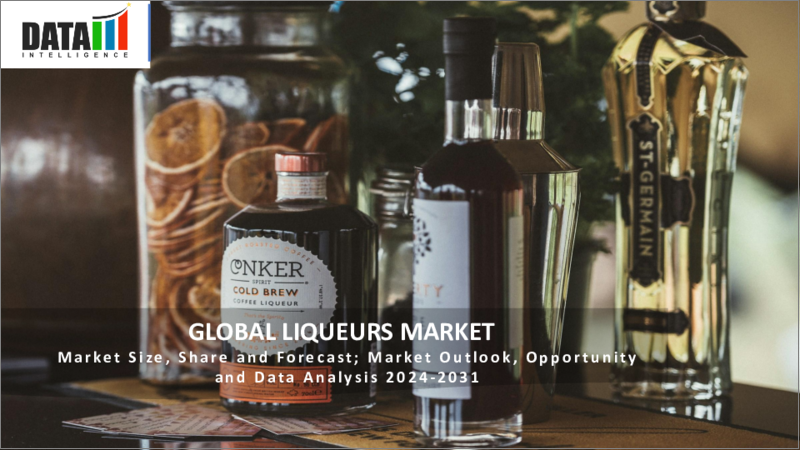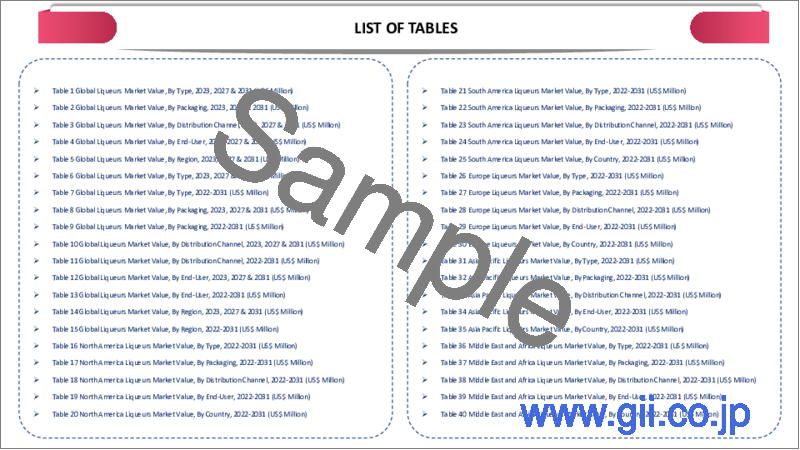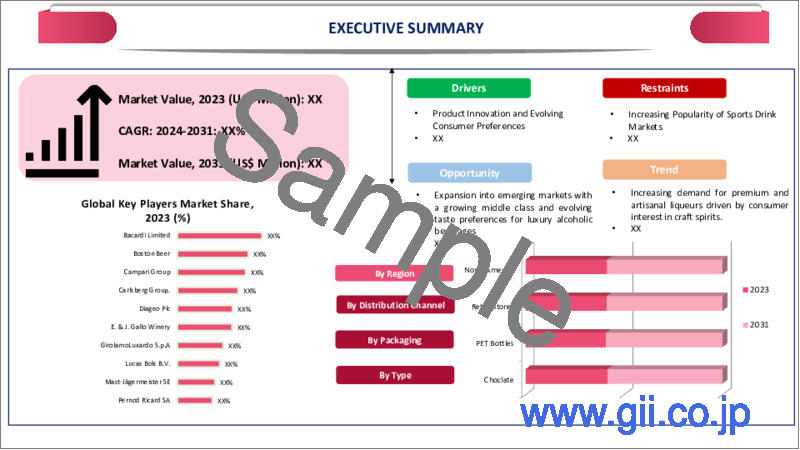|
|
市場調査レポート
商品コード
1325304
世界のリキュール市場-2023年~2030年Global Liquers Market - 2023-2030 |
||||||
カスタマイズ可能
適宜更新あり
|
|||||||
| 世界のリキュール市場-2023年~2030年 |
|
出版日: 2023年08月04日
発行: DataM Intelligence
ページ情報: 英文 190 Pages
納期: 即日から翌営業日
|
- 全表示
- 概要
- 目次
市場概要
世界のリキュール市場は、予測期間中 (2023年~2030年) に6.4%のCAGRで成長する見通しです。世界のリキュール市場の成長は、主に可処分所得が大きい若年層の人口増加と、プレミアムおよびスーパープレミアム製品への消費者の強い志向によって推進されています。
メーカーや新規企業は、ユニークなフレーバーを特徴とする新製品の投入にますます注力するようになっており、これが業界内の健全な競争を促進し、世界のリキュール市場規模の拡大につながっています。さらに、消費者は持続可能性と倫理的慣行に対する意識を高めており、環境に優しく社会的責任に配慮した取り組みを優先するリキュール・ブランドは、環境意識の高い消費者層を引き付けています。
市場全体の成長を後押しするため、販売業者は顧客を魅了し惹きつけることを目的とした販促キャンペーンに積極的に投資しています。さらに、eコマース・プラットフォームの影響力の高まりは、リキュール市場の裾野を広げ、より多くの消費者に便利なアクセスを提供し、世界の市場規模をさらに押し上げています。
市場力学
継続的な製品投入がリキュール世界市場の成長促進に重要な役割を果たす
メーカーやブランドは革新的なリキュール新製品を継続的に発売し、消費者の嗜好や需要の変化に対応しています。こうした頻繁な製品の発売は、消費者の関心と興味を引きつけるだけでなく、各ブランドの市場競争力維持にも役立っています。例えば、テキーラ・カザドレスは2023年7月18日、爆発的な流行を利用したテキーラ・ベースの最新コーヒー・リキュール「カザドレス・カフェ」を発売しました。この新しいアルコール度数33%のリキュールは、カサドレス・ブランコにコーヒーとアガベを混ぜたものです。
一方、2023年6月1日、ニューヨークのリキュール・メーカー、ハイマットは「リキュール、ブラックカラント」を発売しました。ハドソン・バレーにあるニューヨーク初の商業スグリ農園CurrantCのスグリを使用し、ブラックカラントを製造。ニューヨークとニュージャージーのショップ、バー、レストランで購入できる(希望小売価格29ドル/375ml)。
革新的飲料の普及が市場拡大を牽引
消費者が斬新で刺激的な飲用体験を求めるため、革新的な飲料は新規顧客を惹きつけるだけでなく、既存顧客の維持にも役立っています。この動向は、飲食品や飲料に対して冒険的かつ実験的なアプローチをとることで知られる若年層やミレニアル世代に特に浸透しています。
さらに、ミクソロジーとカクテル文化の台頭は、シグネチャー・カクテルやドリンク・レシピを作るのに不可欠な材料として、革新的なリキュールの需要を増幅させています。バーテンダーやミクソロジストは、顧客のために革新的でユニークな飲料を作るために、常に新しく刺激的なリキュールを求めています。
スポーツドリンク市場の人気の高まりが市場拡大の妨げに
水性添加物市場は、厳しい規制環境の存在と、管理団体によって実施されるコンプライアンス要件のために課題に遭遇しています。これらの規制は、養殖に利用される添加物の安全性、有効性、環境の持続可能性を保証するために実施されています。しかし、メーカーやサプライヤーにとって、入り組んだ規制状況を乗り切ることは、手間とコストのかかるプロセスです。
COVID-19影響分析
COVID-19分析には、COVID前シナリオ、COVIDシナリオ、COVID後シナリオに加え、価格動向(COVID前シナリオと比較したパンデミック中およびパンデミック後の価格変動を含む)、需給スペクトラム(取引制限、封鎖、およびその後の問題による需給の変化)、政府の取り組み(政府機関による市場、セクター、産業を活性化させる取り組み)、メーカーの戦略的取り組み(COVID問題の緩和に向けたメーカーの対策)が含まれます。
人工知能分析
人工知能(AI)分析はリキュール業界に革命を起こし、貴重な洞察を提供し、ビジネスの様々な側面を変革しています。予測分析により、メーカーは需要パターンと消費者の嗜好を正確に予測することで、生産と在庫管理を最適化できます。AI提言システムを活用した個別化マーケティングは、顧客エンゲージメントとブランドロイヤルティを高めます。品質管理は、AI主導のセンサーと画像認識技術によって強化され、製造工程における一貫した製品品質を保証します。例えば、2022年7月5日、ディアジオは消費者の酒類選択を提案するVivanda AI Companyを買収しました。ディアジオは2019年から、前者の「What's Your Whisky」プラットフォームで、さらにジョニーウォーカーのサンプリング場所での「Journey of Flavour」体験でVivandaのシステムを使用しています。
目次
第1章 調査手法と調査範囲
第2章 市場の定義と概要
第3章 エグゼクティブサマリー
第4章 市場力学
- 市場への影響要因
- 促進要因
- 抑制要因
- 機会
- 影響分析
第5章 産業分析
- ポーターのファイブフォース分析
- サプライチェーン分析
- 価格分析
- 規制分析
第6章 COVID-19分析
第7章 タイプ別
- チョコレート
- クリーム
- コーヒー
- ハーブ
- フローラル
- ナッツ
- シトラス
- フルーティー
- 大麻入り
- コーシャ・リキュール
第8章 エンドユーザー別
- 家庭用
- チョコレート
- クリーム
- コーヒー
- ハーブ
- フローラル
- ナッツ
- シトラス
- フルーティー
- ヘンプ入り
- コーシャー・リキュール
- 非家庭用
- チョコレート
- クリーム
- コーヒー
- ハーブ
- フローラル
- ナッツ
- シトラス
- フルーティー
- ヘンプ入り
- コーシャ・リキュール
第9章 パッケージ
- ガラス
- ペットボトル
- 金属缶
- その他
第10章 流通チャネル別
- スーパーマーケット/ハイパーマーケット
- 小売店
- フードサービス
- その他
第11章 地域別
- 北米
- 米国
- カナダ
- メキシコ
- 欧州
- ドイツ
- 英国
- フランス
- イタリア
- スペイン
- その他欧州
- 南米
- ブラジル
- アルゼンチン
- その他南米
- アジア太平洋
- 中国
- インド
- 日本
- オーストラリア
- その他アジア太平洋
- 中東・アフリカ
第12章 競合情勢
- 競合シナリオ
- 市況/シェア分析
- M&A分析
第13章 企業プロファイル
- William Grant & Sons
- 企業概要
- 製品ポートフォリオと説明
- 財務概要
- 主な動向
- Boston Beer
- Miller Coors
- Diageo
- Treasury Wine Estates
- Jose Cuervo
- Constellation Brands
- Beam-Suntory
- Mast-Jaegermeister
- Bacardi
第14章 付録
Market Overview
Global Liqueurs Market reached US$ XX million in 2022 and is expected to reach US$ XX million by 2030 growing with a CAGR of 6.4% during the forecast period 2023-2030. The growth of the global liqueur market is primarily propelled by a rising population of young adults with significant disposable income, along with a strong consumer inclination towards premium and super-premium products.
Manufacturers and emerging players are increasingly focusing on introducing new products featuring unique flavors, which fosters healthy competition within the industry, leading to the expansion of the global liqueur market size. Moreover, consumers are becoming more conscious of sustainability and ethical practices, and liqueur brands prioritizing environmentally friendly and socially responsible initiatives attract a growing environmentally conscious consumer base.
To boost overall market growth, dealers are actively investing in promotional campaigns aimed at captivating and engaging customers. Additionally, the growing influence of e-commerce platforms has widened the liqueur market's reach, offering convenient access to a broader audience, further driving its global size.
Market Dynamics
Continuous Product Launches are Playing a Pivotal Role in Driving the Growth of Global Liqueur Market
As manufacturers and brands continue to launch new and innovative liqueur products, they cater to evolving consumer preferences and demands. These frequent product launches not only keep consumers engaged and interested but also help brands stay competitive in the market. For instance, on July 18, 2023, Tequila Cazadores launched Cazadores Cafe, the latest tequila-based coffee liqueur to capitalize on an exploding trend. The new 33% ABV liqueur is a variation of Cazadores Blanco infused with a mix of coffee and agave.
On the other hand, on June 01, 2023, Heimat the New York based liqueurs manufacturer launched "Liqueur, Black Currant". The currants from the first commercial currant farm in New York, CurrantC in the Hudson Valley, to produce Black Currant. It is available at shops, bars, and restaurants in New York and New Jersey (SRP $29/375ml).
Increasing Adoption of Innovative Beverages is Driving the Market Expansion
Innovative beverages not only attract new customers but also help retain existing ones, as consumers seek novel and exciting drinking experiences. This trend is particularly prevalent among young adults and the millennial generation, who are known for their adventurous and experimental approach to food and beverages.
Furthermore, the rise of mixology and the cocktail culture has amplified the demand for innovative liqueurs as essential ingredients in creating signature cocktails and drink recipes. Bartenders and mixologists constantly seek out new and exciting liqueur offerings to craft innovative and unique beverages for their customers.
Increasing Popularity of Sports Drink Markets is Hampering the Market Expansion
The aquatic additives market is encountering challenges due to the presence of a stringent regulatory environment and compliance requirements enforced by governing bodies. These regulations are implemented to guarantee the safety, efficacy, and environmental sustainability of the additives utilized in aquaculture. However, for manufacturers and suppliers, navigating through the intricate regulatory landscape can be a laborious and costly process.
COVID-19 Impact Analysis
The COVID-19 Analysis includes Pre-COVID Scenario, COVID Scenario and Post-COVID Scenario along with Pricing Dynamics (Including pricing change during and post-pandemic comparing it with pre-COVID scenarios), Demand-Supply Spectrum (Shift in demand and supply owing to trading restrictions, lockdown, and subsequent issues), Government Initiatives (Initiatives to revive market, sector or Industry by Government Bodies) and Manufacturers Strategic Initiatives (What manufacturers did to mitigate the COVID issues will be covered here).
Artificial Intelligence Analysis
Artificial Intelligence (AI) analysis is revolutionizing the liqueur industry, providing valuable insights and transforming various aspects of the business. With predictive analytics, manufacturers can optimize production and inventory management by accurately predicting demand patterns and consumer preferences. Personalized marketing powered by AI recommendation systems enhances customer engagement and brand loyalty. Quality control is strengthened through AI-driven sensors and image recognition technologies, ensuring consistent product quality during the manufacturing process. For instance, on July 5, 2022, Diageo acquired Vivanda AI Company that suggests consumer liquor choices. Diageo has used Vivanda's system since 2019 in the former's "What's Your Whisky" platform and more in the Journey of Flavour experience at a Johnnie Walker sampling location.
Segment Analysis
The global liqueurs market is segmented based on type, packaging, end user, distribution channel and region.
In the Global Market of Liqueurs, By Type, the Chocolote Segment Holds the Largest Market Share
The popularity of chocolate liqueurs is driven by their delightful and indulgent taste profile, combining the rich flavors of chocolate with the smoothness of liqueurs. Consumers are drawn to the luxurious and satisfying experience that chocolate liqueurs offer, making them a preferred choice in the liqueur market.
Manufacturers are continuously innovating and introducing new chocolate liqueur flavors and variations to attract consumers and stand out in the market. For instance, on October 3, 2022, Zamora Company USA, launched Licor 43 Chocolate Liqueur. Licor 43 Chocolate (16% ABV) is a fusion of the popular Licor 43 Original liqueur and chocolate from 100% sustainably sourced cocoa.
Geographical Analysis
North America Held the Largest Market Share in the Liqueurs Market
In 2022, the North America region accounted for approximately 32.5% of the market share in the global liqueurs market. The region's leadership is attributed to several factors, including a well-established consumer base with a strong affinity for alcoholic beverages, the presence of renowned liqueur brands, and a thriving cocktail culture that fuels demand. Moreover, the region's growing interest in craft and premium beverages, coupled with increasing disposable incomes, further drives the popularity of liqueurs.
Additionally, the accessibility of liqueurs and other spirits items in home grocery stores and the influence of e-commerce platforms contribute to the region's market dominance. North America's proactive investment in promotional campaigns and its embrace of product innovations align with changing consumer preferences, ensuring its continued dominance in the global liqueurs market. For instance, on April 15, 2023, Filipino ube liquor soft launched Ube Cream Liqueur in the U.S.
Competitive Landscape
The major global players in the market include William Grant & Sons, Boston Beer, Miller Coors, diageo, Treasury Wine Estates, Jose Cuervo, Constellation Brands, Beam-Suntory, Mast-Jaegermeister and Bacardi.
Why Purchase the Report?
- To visualize the global liqueurs market is segmented based on type, packaging, end user, distribution channel and region, as well as understand key commercial assets and players.
- Identify commercial opportunities in the market by analyzing trends and co-development.
- Excel data sheet with numerous data points of liqueurs market-level with all segments.
- The PDF report consists of cogently put-together market analysis after exhaustive qualitative interviews and in-depth market study.
- Product mapping is available as Excel consists of key products of all the major market players.
The global liqueurs market report would provide approximately 61 tables, 58 figures and 190 Pages.
Target Audience 2023
- Manufacturers/ Buyers
- Industry Investors/Investment Bankers
- Research Professionals
- Emerging Companies
Table of Contents
1. Methodology and Scope
- 1.1. Research Methodology
- 1.2. Research Objective and Scope of the Report
2. Market Definition and Overview
3. Executive Summary
- 3.1. Market Snippet, by Type
- 3.2. Market Snippet, by Packaging
- 3.3. Market Snippet, by End-User
- 3.4. Market Snippet, by Distribution Channel
- 3.5. Market Snippet, by Region
4. Market Dynamics
- 4.1. Market Impacting Factors
- 4.1.1. Drivers
- 4.1.2. Restraints
- 4.1.3. Opportunity
- 4.1.4. Impact Analysis
5. Industry Analysis
- 5.1. Porter's Five Force Analysis
- 5.2. Supply Chain Analysis
- 5.3. Pricing Analysis
- 5.4. Regulatory Analysis
6. COVID-19 Analysis
- 6.1. Analysis of COVID-19
- 6.1.1. Scenario Before COVID-19
- 6.1.2. Scenario During COVID-19
- 6.1.3. Scenario Post COVID-19
- 6.2. Pricing Dynamics Amid COVID-19
- 6.3. Demand-Supply Spectrum
- 6.4. Government Initiatives Related to the Market During Pandemic
- 6.5. Manufacturers Strategic Initiatives
- 6.6. Conclusion
7. By Type
- 7.1. Introduction
- 7.1.1. Market Size Analysis and Y-o-Y Growth Analysis (%), By Type
- 7.1.2. Market Attractiveness Index, By Type
- 7.2. Chocolate *
- 7.2.1. Introduction
- 7.2.2. Market Size Analysis and Y-o-Y Growth Analysis (%)
- 7.3. Creme
- 7.4. Coffee
- 7.5. Herbal
- 7.6. Floral
- 7.7. Nutty
- 7.8. Citrus
- 7.9. Fruity
- 7.10. Cannabis Infused
- 7.11. Kosher Liqueurs
8. By End-User
- 8.1. Introduction
- 8.1.1. Market Size Analysis and Y-o-Y Growth Analysis (%), By End-User
- 8.1.2. Market Attractiveness Index, By End-User
- 8.2. Residential *
- 8.2.1. Introduction
- 8.2.2. Market Size Analysis and Y-o-Y Growth Analysis (%)
- 8.2.3. Chocolate
- 8.2.4. Creme
- 8.2.5. Coffee
- 8.2.6. Herbal
- 8.2.7. Floral
- 8.2.8. Nutty
- 8.2.9. Citrus
- 8.2.10. Fruity
- 8.2.11. Cannabis Infused
- 8.2.12. Kosher Liqueurs
- 8.3. Non-Residential
- 8.3.1. Chocolate
- 8.3.2. Creme
- 8.3.3. Coffee
- 8.3.4. Herbal
- 8.3.5. Floral
- 8.3.6. Nutty
- 8.3.7. Citrus
- 8.3.8. Fruity
- 8.3.9. Cannabis Infused
- 8.3.10. Kosher Liqueurs
9. By Packaging
- 9.1. Introduction
- 9.1.1. Market Size Analysis and Y-o-Y Growth Analysis (%), By Packaging
- 9.1.2. Market Attractiveness Index, By Packaging
- 9.2. Glass *
- 9.2.1. Introduction
- 9.2.2. Market Size Analysis and Y-o-Y Growth Analysis (%)
- 9.3. PET Bottle
- 9.4. Metal Can
- 9.5. Others
10. By Distribution Channel
- 10.1. Introduction
- 10.1.1. Market Size Analysis and Y-o-Y Growth Analysis (%), By Distribution Channel
- 10.1.2. Market Attractiveness Index, By Distribution Channel
- 10.2. Supermarkets/Hypermarkets *
- 10.2.1. Introduction
- 10.2.2. Market Size Analysis and Y-o-Y Growth Analysis (%)
- 10.3. Retail Stores
- 10.4. Food Service
- 10.5. Others
11. By Region
- 11.1. Introduction
- 11.1.1. Market Size Analysis and Y-o-Y Growth Analysis (%), By Region
- 11.1.2. Market Attractiveness Index, By Region
- 11.2. North America*
- 11.2.1. Introduction
- 11.2.2. Key Region-Specific Dynamics
- 11.2.3. Market Size Analysis and Y-o-Y Growth Analysis (%), By Type
- 11.2.4. Market Size Analysis and Y-o-Y Growth Analysis (%), By Packaging
- 11.2.5. Market Size Analysis and Y-o-Y Growth Analysis (%), By End-User
- 11.2.6. Market Size Analysis and Y-o-Y Growth Analysis (%), By Distribution Channel
- 11.2.7. Market Size Analysis and Y-o-Y Growth Analysis (%), By Country
- 11.2.7.1. The U.S.
- 11.2.7.2. Canada
- 11.2.7.3. Mexico
- 11.3. Europe
- 11.3.1. Introduction
- 11.3.2. Key Region-Specific Dynamics
- 11.3.3. Market Size Analysis and Y-o-Y Growth Analysis (%), By Type
- 11.3.4. Market Size Analysis and Y-o-Y Growth Analysis (%), By Packaging
- 11.3.5. Market Size Analysis and Y-o-Y Growth Analysis (%), By End-User
- 11.3.6. Market Size Analysis and Y-o-Y Growth Analysis (%), By Distribution Channel
- 11.3.7. Market Size Analysis and Y-o-Y Growth Analysis (%), By Country
- 11.3.7.1. Germany
- 11.3.7.2. The U.K.
- 11.3.7.3. France
- 11.3.7.4. Italy
- 11.3.7.5. Spain
- 11.3.7.6. Rest of Europe
- 11.4. South America
- 11.4.1. Introduction
- 11.4.2. Key Region-Specific Dynamics
- 11.4.3. Market Size Analysis and Y-o-Y Growth Analysis (%), By Type
- 11.4.4. Market Size Analysis and Y-o-Y Growth Analysis (%), By Packaging
- 11.4.5. Market Size Analysis and Y-o-Y Growth Analysis (%), By End-User
- 11.4.6. Market Size Analysis and Y-o-Y Growth Analysis (%), By Distribution Channel
- 11.4.7. Market Size Analysis and Y-o-Y Growth Analysis (%), By Country
- 11.4.7.1. Brazil
- 11.4.7.2. Argentina
- 11.4.7.3. Rest of South America
- 11.5. Asia-Pacific
- 11.5.1. Introduction
- 11.5.2. Key Region-Specific Dynamics
- 11.5.3. Market Size Analysis and Y-o-Y Growth Analysis (%), By Type
- 11.5.4. Market Size Analysis and Y-o-Y Growth Analysis (%), By Packaging
- 11.5.5. Market Size Analysis and Y-o-Y Growth Analysis (%), By End-User
- 11.5.6. Market Size Analysis and Y-o-Y Growth Analysis (%), By Distribution Channel
- 11.5.7. Market Size Analysis and Y-o-Y Growth Analysis (%), By Country
- 11.5.7.1. China
- 11.5.7.2. India
- 11.5.7.3. Japan
- 11.5.7.4. Australia
- 11.5.7.5. Rest of Asia-Pacific
- 11.6. Middle East and Africa
- 11.6.1. Introduction
- 11.6.2. Key Region-Specific Dynamics
- 11.6.3. Market Size Analysis and Y-o-Y Growth Analysis (%), By Type
- 11.6.4. Market Size Analysis and Y-o-Y Growth Analysis (%), By Packaging
- 11.6.5. Market Size Analysis and Y-o-Y Growth Analysis (%), By End-User
- 11.6.6. Market Size Analysis and Y-o-Y Growth Analysis (%), By Distribution Channel
12. Competitive Landscape
- 12.1. Competitive Scenario
- 12.2. Market Positioning/Share Analysis
- 12.3. Mergers and Acquisitions Analysis
13. Company Profiles
- 13.1. William Grant & Sons
- 13.1.1. Company Overview
- 13.1.2. Product Portfolio and Description
- 13.1.3. Financial Overview
- 13.1.4. Key Developments
- 13.2. Boston Beer
- 13.3. Miller Coors
- 13.4. Diageo
- 13.5. Treasury Wine Estates
- 13.6. Jose Cuervo
- 13.7. Constellation Brands
- 13.8. Beam-Suntory
- 13.9. Mast-Jaegermeister
- 13.10. Bacardi
LIST NOT EXHAUSTIVE
14. Appendix
- 14.1. About Us and Services
- 14.2. Contact Us






